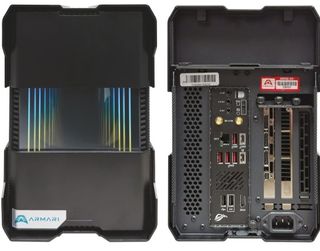The diminutive Magnetar packs an incredible amount of power into its tiny case. This is a tiny system that looks great and performs well beyond what you’d expect from a workstation this small.
Pros
- +
A quarter to a third smaller than typical workstations
- +
Two storage drives
- +
Competitive performance
Cons
- –
No USB or audio ports on the fron
Why you can trust TechRadar We spend hours testing every product or service we review, so you can be sure you’re buying the best. Find out more about how we test.
Armari decided to provide us with something a little different for its £4,500 workstation entry this year. Instead of the classic black box like something out of 2001: A Space Odyssey, the Magnetar PrMM16R9 is small – very small. Yet it packs in the same workstation-grade components found in more conventional systems.
The Magnetar uses a Phanteks Evolv Shift XT chassis, which is a quarter to a third smaller in every dimension than other cases this month. The physical appearance with angled corners is stylish, but the infinity mirror on the front is mesmeric, looking like a lit passageway extending unfeasibly into the front of the case. This is a chassis you’ll want to display on your desk as a statement rather than hiding it below. Yet it still sports a 240mm liquid-cooling system for the CPU and an 850W PSU. Although there’s not much room for extra storage in a case this small, the only avoidable downside is that there are no USB or audio ports on the front.
There was a hope that this system could be supplied with the AMD Ryzen 9 9950X, but this member of the new 9000-series wasn’t quite ready for testing at the time of writing. Instead, Armari sent this system with the previous-generation 7950X, but it will ship the final version with the 9950X for the price quoted above. The 7950X provides the same 16 cores as the 9950X, running at a base 4.5GHz with a 5.7GHz boost, whereas the 9950X will have the same boost frequency but an improved core design.
Armari partners the Ryzen 9 with a hefty 96GB of 5,600MHz DDR5 RAM, supplied as two 48GB modules. This takes up both DIMM slots on the Asus ROG Strix B650E-I Gaming WiFi motherboard, but you probably won’t want more in a small system such as this one.
Despite its size, the PrMM16R9 has room for a dual-width graphics card, in this case the AMD Radeon Pro W7800. It could, apparently, take an even wider accelerator such as the triple-width W7900. The W7800 sports 4,800 Stream Processors and 32GB of GDDR6 memory delivering 576GB/sec of bandwidth.

Another surprising inclusion for such a diminutive system are the two storage drives. The main one is a 2TB Crucial T705 NVMe M.2 device, with a PCI Express 5 interface. This delivered 8,413MB/sec sustained reading and 7,792MB/sec writing using CrystalDiskMark 8. Then there’s a secondary 2TB Kioxia Exceria Pro NVMe drive running at PCI Express 4 speeds and providing 7,095MB/sec reading alongside 3,218MB/sec writing speeds.
Although the Magnetar’s AMD Ryzen 9 7950X is the previous CPU generation now, it packs a punch. An overall score of 729 in the PC Pro media benchmarks still beats the InterPro’s Core i9-14900K CPU, with solid results of 289 in image editing, 692 in video encoding and 901 in multitasking. The multi-CPU render result with Maxon Cinebench 2024 of 1,991 is also slightly faster. The Blender Gooseberry frame took 283 seconds, which surpassed all the other systems in the £4,500 class. Considering the performance of the 12-core Ryzen 9000 series used by Scan, with the 9950X in this system instead of the 7950X, the results would be very competitive indeed.
The AMD Radeon Pro W7800 performs well. In SPECviewperf 2020, results of 230 in 3dsmax-07 and 757 in maya-06 show excellent 3D animation modelling ability. And 169 in catia-06, 238 in creo-03 and 600 in snx-04, with a decent 438 in solidworks-07, imply capable CAD and engineering abilities. The AI inference score of 24,623 in the Geekbench ML, 12,617 with LuxMark 3.1 OpenCL, and Blender Gooseberry frame time of 145 seconds are about what we’d expect from this GPU.
With our review sample relying on a previous-generation AMD Ryzen, the Armari Magnetar PrMM16R9 couldn’t win this Labs test; although the upgrade will be at no extra cost by the time you read this, we can’t confirm the performance until we try it. But this is still a great-looking compact system that punches way above its size. It has plenty to commend it to anyone looking for a stylish yet powerful desk-friendly workstation.
This review first appeared in Issue 361 of PC Pro.
